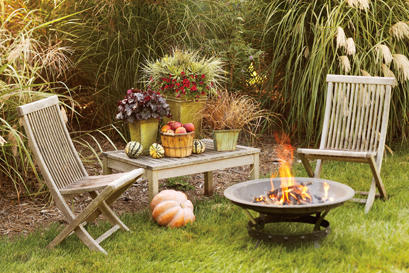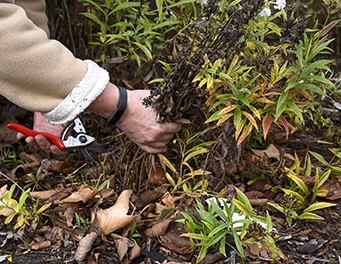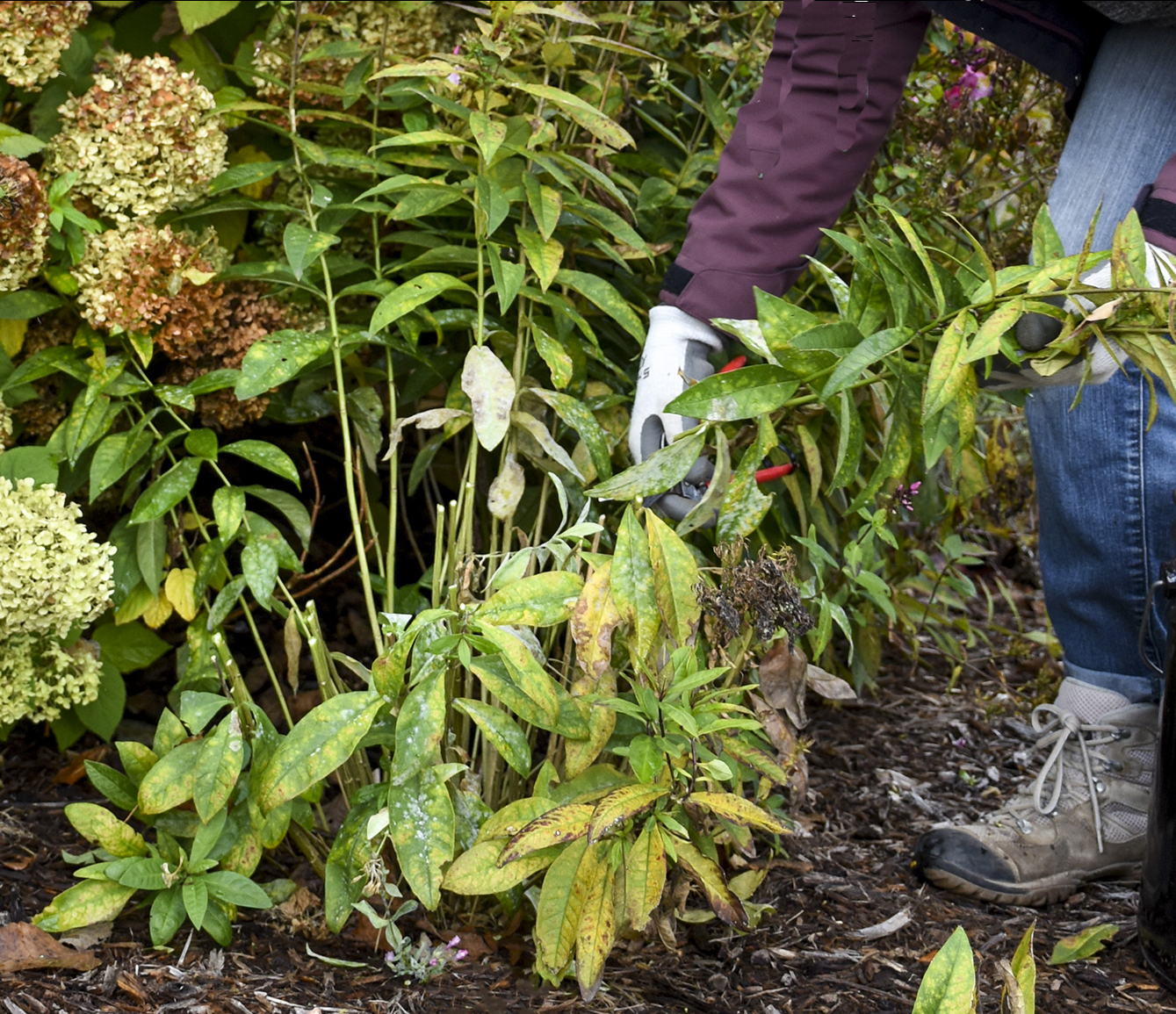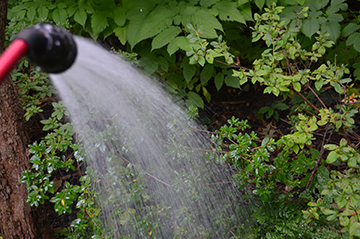10 Fall Gardening Tasks to Make Your Garden Sing Next Spring
It’s not time to hang up your rake until the last gardening tasks of the season are complete. Here are ten essential fall tasks to finish before the snow flies to ensure your garden will shine next spring.

1. Do an honest evaluation of your garden. What worked this year? What wouldn’t you repeat next year? Do yourself a favor and start a list now that you can use when you shop next spring. Fall is also a good time of year to evaluate:
|
| 2. Remove annuals from containers and landscapes. It was a great run, but by the time fall rolls around, it’s time for the annuals to go and store your pots away for winter. It can be tough to do since long bloomers like Supertunia Vista® Bubblegum® and Salvia Rockin’® Playin’ the Blues® can still look great in the fall, but once frost hits you’ll wish you had pulled them sooner. Healthy annuals can be composted; any diseased plants should be disposed of. |
 3. Fall is for planting! Still-warm soil and relatively cool air temperatures promote healthy root growth in plants that return each year. Take advantage of end of season sales on trees and shrubs at local nurseries, and divide or move perennials around the garden in fall. Ideally, give the roots at least six weeks to settle into their new home before the ground freezes. Read more about fall planting in this article. 3. Fall is for planting! Still-warm soil and relatively cool air temperatures promote healthy root growth in plants that return each year. Take advantage of end of season sales on trees and shrubs at local nurseries, and divide or move perennials around the garden in fall. Ideally, give the roots at least six weeks to settle into their new home before the ground freezes. Read more about fall planting in this article. |
| 4. Plant spring blooming bulbs. Fall is the best time to plant spring flowering bulbs like tulips, daffodils, crocuses, and a wide variety of others you’ll find at your local garden center this time of year. Pair them with perennials like Shadowland® hostas and ‘Cat’s Meow’ catmint so the bulbs’ foliage will be hidden by the time it goes dormant. If squirrels, voles or chipmunks are a problem in your garden, spray the bulbs with an animal repellant before you plant them or cover them with a layer of chicken wire to prevent animals from digging them back up. |
 5. Cut select perennials back. Once your perennials have gone dormant, it’s a good idea to clean at least some of their foliage out of garden beds. We typically cut them right down to the ground. This is especially important around plants like hostas that have received slug damage during the growing season. Slugs lay their eggs in the dormant foliage, and removing it in fall will cut down on slug issues the following year. Fall is not the best time to prune shrubs. You'll find more information about that topic here. 5. Cut select perennials back. Once your perennials have gone dormant, it’s a good idea to clean at least some of their foliage out of garden beds. We typically cut them right down to the ground. This is especially important around plants like hostas that have received slug damage during the growing season. Slugs lay their eggs in the dormant foliage, and removing it in fall will cut down on slug issues the following year. Fall is not the best time to prune shrubs. You'll find more information about that topic here. DO NOT cut these perennials back in fall:
|
6 . Dispose of diseased foliage. While most of the plants you cut back in fall can go in your compost pile, you’ll want to avoid putting any plants with diseased foliage there. That’s because most compost piles don’t heat up enough to kill diseases, and you don’t want to risk spreading them back into your garden next year. Gather as much of the diseased foliage as you can, bag and seal it, then dispose of it in the trash. . Dispose of diseased foliage. While most of the plants you cut back in fall can go in your compost pile, you’ll want to avoid putting any plants with diseased foliage there. That’s because most compost piles don’t heat up enough to kill diseases, and you don’t want to risk spreading them back into your garden next year. Gather as much of the diseased foliage as you can, bag and seal it, then dispose of it in the trash. |
| 7. Bring the outdoors in. Fall is the perfect time to gather cut branches and dried flowers from the garden to use in your indoor decorating projects. Hydrangea flowers, berried branches, ornamental grass plumes, and plants with seed pods can all be brought indoors this time of year. Find all kinds of how-to projects for every season here. |
|
9. R ake, shred, and mulch with leaves. Nature delivers natural mulch at our feet every fall when deciduous trees drop their leaves. Finely textured leaves from willow trees or honey locusts will easily degrade on their own and don’t need to be raked. But broad leaves from maple, sycamore, oak trees and the like become matted down and take a long time to decompose on their own, potentially smothering your grass and perennials. These kinds of leaves should be raked out of garden beds and mowed on the lawn. ake, shred, and mulch with leaves. Nature delivers natural mulch at our feet every fall when deciduous trees drop their leaves. Finely textured leaves from willow trees or honey locusts will easily degrade on their own and don’t need to be raked. But broad leaves from maple, sycamore, oak trees and the like become matted down and take a long time to decompose on their own, potentially smothering your grass and perennials. These kinds of leaves should be raked out of garden beds and mowed on the lawn.It may seem counterintuitive, but it's a good idea to spread the shredded leaves back onto your garden beds as mulch in late fall as the ground begins to freeze. Doing so will keep weeds at bay, insulate your plants over the winter months, and enrich the soil as the leaves break down. |
| 10. Protect sensitive and newly planted perennials and shrubs. If you’re pushing the hardiness zone on a few of your plants, heaping a pile of shredded leaves or evergreen boughs on top of them once they are dormant may help them make it through the winter. This same technique works for plants with cold sensitive buds like some Hydrangea macrophylla cultivars. Additionally, it’s a good idea to mulch newly planted perennials and shrubs that aren’t well-rooted in yet to prevent the rootball from heaving out of the ground during the freeze/thaw cycles of winter. Mulch helps to keep the soil at a more consistent temperature. |
Bonus Task #11: Start dreaming about next year’s garden! It’s never too early to start planning for spring. Hope springs eternal in the garden.





